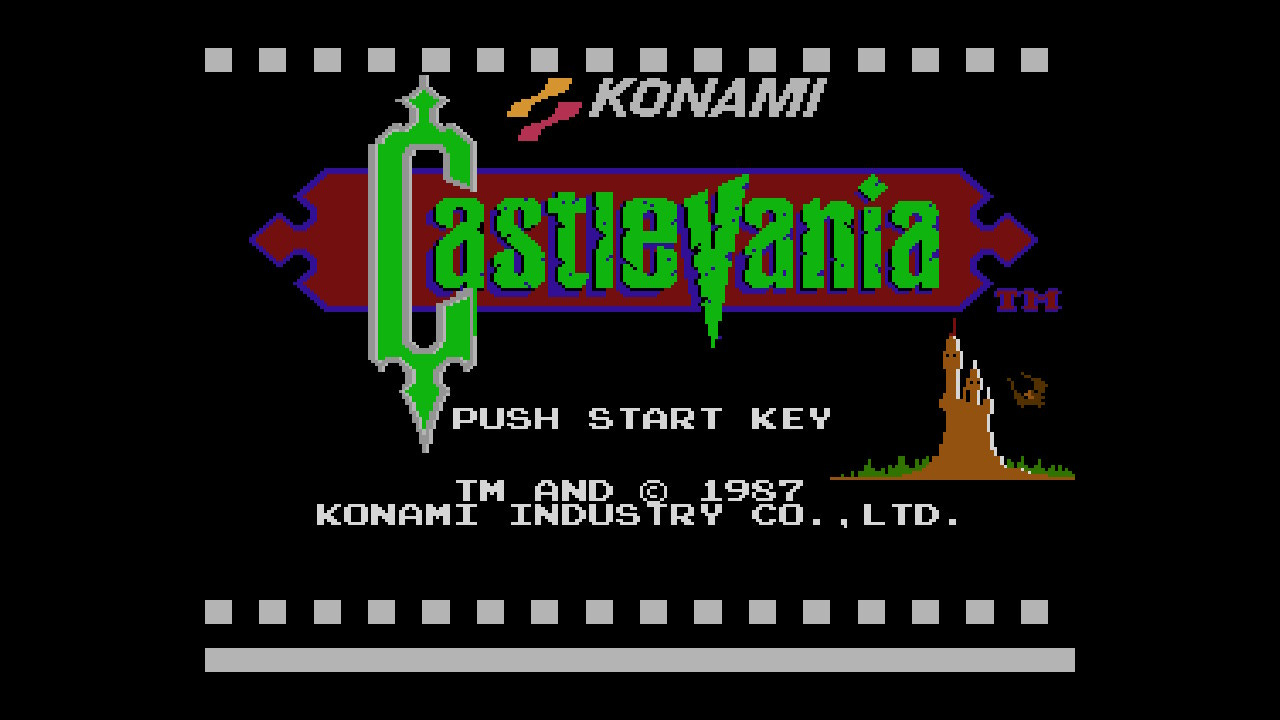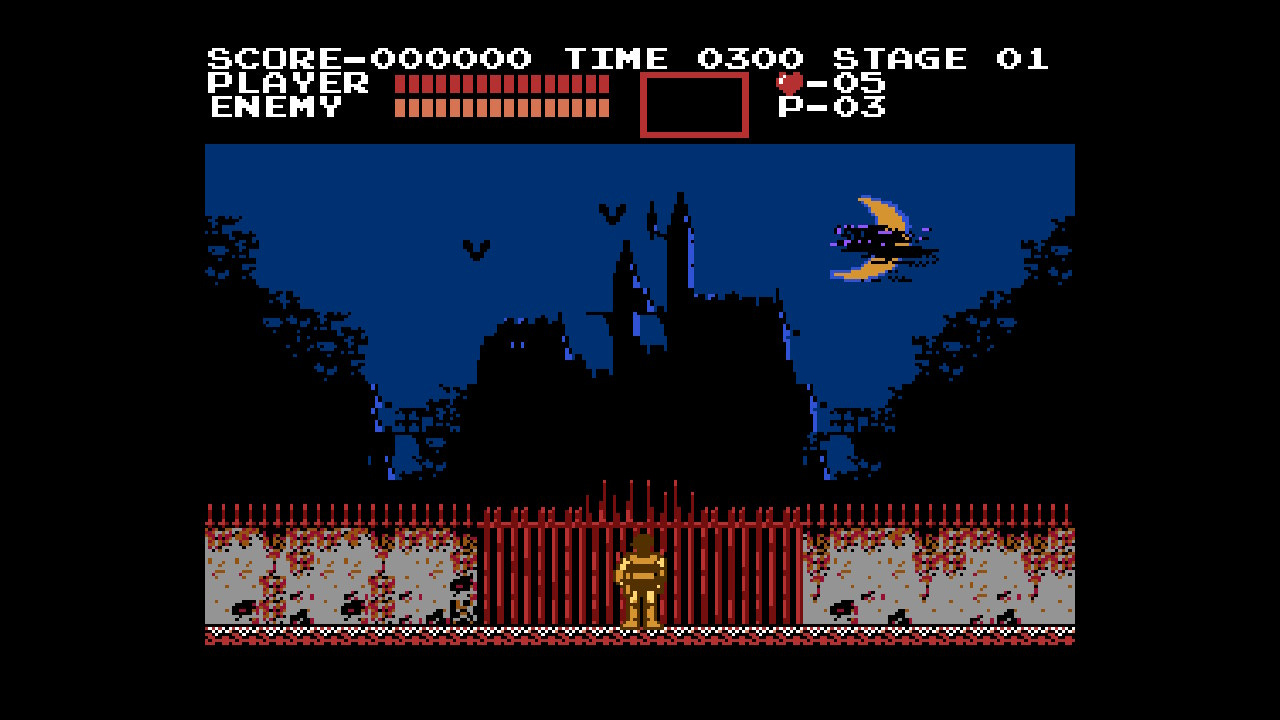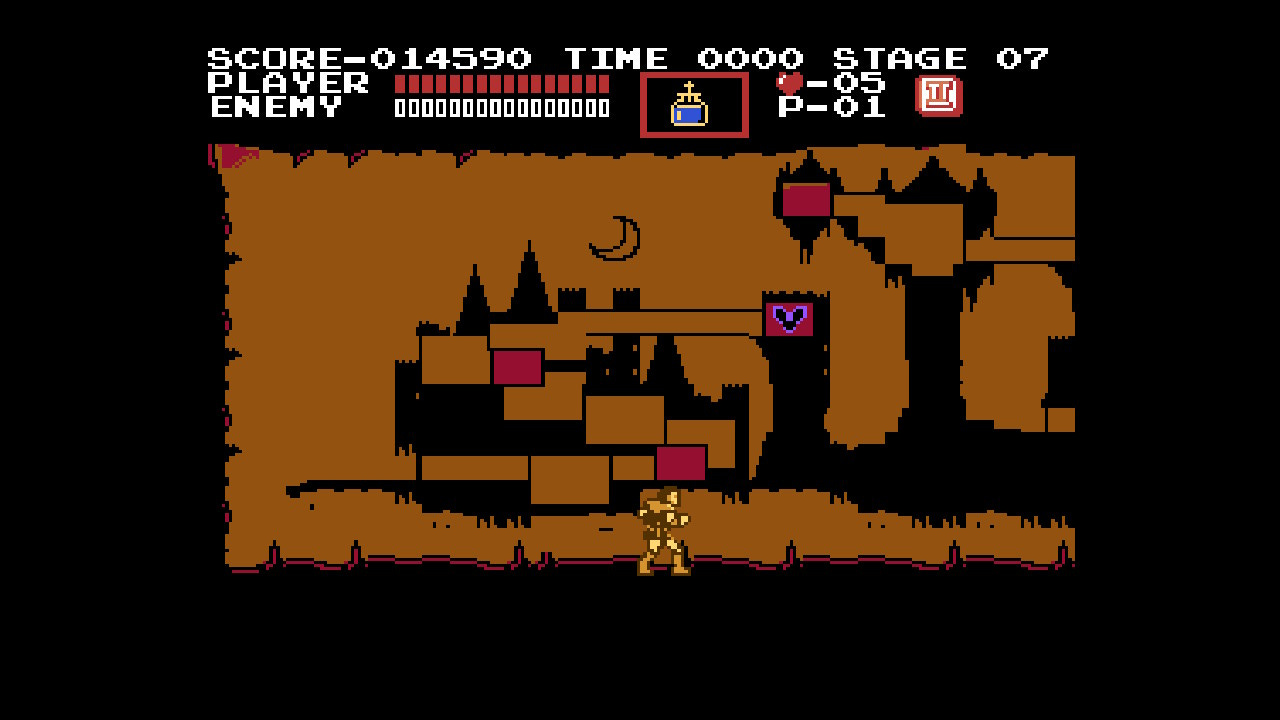Retro spotlight: Castlevania
The Dracula-fighting action game that started it all plays much differently than future Castlevania titles, but is still loads of fun decades later.
This column is “Retro spotlight,” which exists mostly so I can write about whatever game I feel like even if it doesn’t fit into one of the other topics you find in this newsletter. Previous entries in this series can be found through this link.
Look at the video games of the 1980s long enough, and it becomes clear in a hurry that a significant percentage of the titles from that era that you could play in your living room started out in the arcades. Castlevania is the rarity that worked in the opposite direction: a home console release so good that it made sense for Konami to make an arcade edition to capitalize on its popularity and quality. And, in another example of an 80s rarity, the home edition is the better game, too.
Castlevania was first released on Nintendo’s Famicom Disk System in the fall of 1986, where it was known as Akumajō Dracula, which roughly translates to Demon Castle Dracula. It would receive a North American cartridge release a little over half-a-year later, where it would be called Castlevania. While Castlevania is certainly all-encompassing as a franchise name these days, it wasn’t a guarantee at this point that Konami was going to stick with it in the long run. While the MSX2 release was also titled Akumajō Dracula in Japan, in Europe, it was called Vampire Killer, which… yes, that is a thing you do in the game. At least “Demon Castle Dracula” is just a rough translation, “Vampire Killer” is the actual name they went with in English.
When the NES release hit in North America, though, someone must have realized how basic? goofy? Vampire Killer was, and decided to at least come up with a portmanteau. Hence Castlevania, a combination of castle and Transylvania, the home of Dracula. And hey, Castlevania itself would end up as part of the Metroidvania portmanteau, which… do we have a word for that, a portmanteau inside a portmanteau? Would that genre have found the success it did if we had to call them Metroidvampirekillers? I think not. And we still weren’t completely in the clear even after the name we now know the series by now came to be, as the arcade edition of Castlevania was titled Haunted Castle. Which, again, yes, that’s true, but you could and should do better than that.
Castlevania might have had the word “Dracula” in its original Japanese title, but Dracula is far from the only famous monster you’ll be fighting within. The boss of the second stage is a giant floating Medusa head, there are multiple mummies in stage three’s boss battle, both Frankenstein’s monster and Igor are facing off against you in stage four, Death itself attempts to stop you in stage five, and then there’s classic Drac in the game’s final stage, including in his demon form.
Many of the game’s non-boss enemies fall within the “it came from the deep/underground/the night” territory, too, with fish men popping up from underwater, loads of non-vampire bats that still want your blood, zombies, ravens, skeletons, suits of armor that may or may not have someone inside of them yet walk around and attack you either way. All that was missing here from B-movie territory was an alien or robot to complete the package. Castlevania isn’t shy about being an ode to films of the past, either, with the title screen looking like a single 35mm film cell from a larger strip, or the fact the game’s end credits use some real wink wink nudge nudge naming conventions for the “actors” who played the monsters in-game, like “Christopher Bee” for Dracula as a nod to Christopher Lee, who famously played the infamous vampire Count in Hammer Horror’s series of films six times, beginning in 1958 with Horror of Dracula.
This focus on cinema is no surprise if you know anything about Castlevania’s original creator, Hitoshi Akamatsu. While Koji Igarashi gets a ton of credit for the popularity of Castlevania as a series, to the point where he’s the one who made a spiritual successor series with Bloodstained following his departure from Konami, he didn’t even join the studio until years after the first Castlevania was released worldwide, and wasn’t lead on the series until much later than that. Akamatsu, on the other hand, originated and directed the initial Castlevania, and also directed its two Famicom/NES sequels. At the same, though, game credits of the day were in a weird place, where pseudonyms and aliases might be in place of real names if credits even showed up at all, and this wasn’t helped by Akamatsu’s dedication to having Castlevania’s credits be a gag unto themselves. He’s credited as “Vram Stroker” in the original Castlevania, so it took until future interviews released where Akamatsu was identified as the director for people to even be aware that was him.
It helps that we have outlets like Shmuplations attempting to catalog so much that could be lost or unknown abroad otherwise, and stories about Akamatsu are part of that. For instance, one former developer who worked with Akamatsu had a series of tweets about working with him, which included gems that help us circle back here like, “When I told Akamatsu how great I thought the music for Castlevania was, his reply was: ‘That’s because both the visuals and the music were made by people who consciously wanted to do something cinematic.’ And for his part, he tried to add interesting gameplay.”
It’s not quite Ninja Gaiden-levels of cinematic storytelling, but Castlevania still manages to pack an impressive first impression into its opening, in which Simon Belmont shows up outside of the gates of Dracula’s castle, then turns to stare up at its spires and a clouded moon off in the distance. The music is impressive, too, and stands out: there’s a real weight to it that didn’t always exist in games of the era, which were still figuring out just what music in video games was even supposed to be doing and was capable of. Even if you’ve never played the original Castlevania, you probably know the music of its first stage. Or maybe I just listen to more Powerglove than most.
See, now that’s where the Vampire Killer name fits.
Castlevania has some pretty basic gameplay at its core, but it’s very satisfying, and there are enough options for how to go about things that you’ll feel yourself sucked into its systems. You, as Simon Belmont, are equipped with a whip, which, per that Shmuplations post, you can thank Akamatsu’s love for Raiders of the Lost Ark for. The whip has a short range at first, but two upgrades lengthen it, the last of which lets you be reasonably distant from enemies you’re taking out. And you can find secondary attack items with range that help you go beyond the whip’s fairly simple, one-direction approach to dealing damage. The axe fires off in an arc, knives are thrown forward with more range than the whip can reach, the crosses act as a boomerang, bottles of holy water can stun enemies, and the stopwatch briefly stops time, which can let you cause unimpeded damage or even escape from an encounter that’ll cost you more health than it’s worth.
Because the NES has just two face buttons, both of which are already accounted for with jumping and whip attacks, you have to press up on the D-pad to use those secondary weapons. It works real well for the most part, and feels pretty natural after you get used to “oh right, have to press up and be in a situation where I can do that, too,” but there is a time where it can be annoying. And that’s when you’re near steps. You see, because of the same lack of face buttons, you have to press up to climb stairs in Castlevania. You can’t attack with the whip while actively climbing, but you can accidentally get kind of stuck between climbing stairs and using weapons, or at least throwing weapons in the wrong direction because of the stairs. This clip from the first boss fight against Phantom Bat accomplishes a few goals in its 30 seconds, as it shows off the arcing range of the axe, what boss fights are like, and has Simon get sort of stuck on the stairs in the wrong direction as described above:
You might have also noticed a couple of other things, like the heart that’s picked up right at the start of the fight, after being broken out of its hiding place in the wall. Hearts aren’t health, but are what you need to be able to use those secondary items. Each axe throw, for instance, uses up one heart, but some powers require more than that, like the watch that stops time. You don’t just find hearts hidden in breakable blocks and candlesticks on walls, though, but also from defeated enemies. So unless you exclusively use your equipped secondary item or die regularly, you’re probably not in danger of running out of hearts, even with your total resetting after every boss fight, as your remaining hearts become part of your total score, which in turn is how you receive extra lives for Simon.
The other thing you might have noticed is the small block with a Roman numeral II on it: those upgrades, of which there is also a III block, allow you to throw more than one secondary weapon at a time. So you can’t quite spam axes and boomerangs, but you can fire off 2-3 at a time instead of one, upgrade status depending. Which can be huge in a boss fight when you’re low on health or there are multiple foes on screen at once, and you just want to fire off a few crosses and let them boomerang around to clear the screen while you run off and hide.
You have the health you have, for the most part, and when you run out, you lose a life. There are hidden food items that will recover health scattered around levels, so if you ever notice that there’s a section of blocks that would still work as a platform for you even if you were to destroy one with a whip, there might be food in there. As you get used to the cadence and feel of Castlevania, you’ll start to take a lot less damage, anyway, but falling down a hole is an instant death, even if the hole leads to, say, the floor below that you were just on before climbing stairs to the next section. Enemies will do their best to knock you into the holes that exist during the more intense platforming sections, too, so be mindful of their presence, their movement timing, or just make sure you kill them before you attempt that next jump.
Upon dying, you lose your hearts and weapon upgrades, so you go back to the no-reach whip and don’t have a wealth of hearts to rely on for your secondary items. Don’t die if you can help it, is what I’m getting at, especially since the game isn’t super generous with upgrades before boss fights. You’ll get some, sure, but not enough to both upgrade the whip and find a useful secondary item and get enough hearts where you can actually power the thing enough times. There are times where you will die, however, that’s how it goes, but knowing this should mostly teach you to fight even more aggressively to not die, so you don’t have to go in against a boss a second time, but weaker. At least when you die you can continue, and just go back to the start of the stage without your previous point total.
The original Castlevania is a very linear game, which wouldn’t even bear mentioning if not for what series we’re talking about here. Sure, there are little deviations to take to find hidden items, but there’s the main path, which is also the only path. There’s a map screen that shows you how many levels there are — six, with three “stages” that act as checkpoints in each —but it’s just showing you where you’re going next, not implying the existence of other places you could be instead. Castlevania would eventually become nonlinear, as you’d expect from one of the granddaddies of the pathfinder/Metroidvania genre, but it wouldn’t be that way at the beginning.
The MSX2 release of Akumajō Dracula at least hinted at the idea of something non-linear, as it was focused on you finding keys to unlock doors, which meant a whole lot of exploration, far more than in the NES original. It’s not quite as compelling as its console cousin, as it hadn’t nailed down what made being less linear special just yet, so it’s kind of an endless fetch quest to open doors that also features rapidly spawning enemies far too often to not be annoying about it. Still, this is all better than Haunted Castle, which was clearly designed to physically separate you and your quarters by ramping up the difficulty to absurd, unenjoyable degrees. There’s difficult and fun, and there’s holding you up at whip-point to demand your cash, and Haunted Castle feels much more like the latter. At least in this case you can simply say no and walk away to go play something more enjoyable. Like, say, the NES version of Castlevania.
It’s been re-released again and again throughout the years, and can currently be found on the Castlevania Anniversary Collection, which gathered together the three numbered NES Castlevania titles, Super Castlevania IV from the SNES, the Game Boy’s Castlevania: The Adventure and its sequel Belmont’s Revenge, the Genesis-exclusive Castlevania: Bloodlines, and the never-before-released outside of Japan Kid Dracula, which serves as a parody of Castlevania in the same way Konami’s Parodius was for Gradius. Not every game on there is an all-timer by any means, but it’s still convenient and fun that this specific era and style of Castlevania is all in one place like this for much less than it would have cost to buy them all individually on Virtual Console or what have you even just a few years ago.
While there are certainly better Castlevania games out there, the original still holds up: it’s a tight action platformer that pushes you along, challenges you in the right ways, and its ambitions weren’t overly held back by the limited inputs of the era. It’s worth going back to see where the series got its start if you’ve never played before, and if you have, it’s still just as good as you remember it being.
This newsletter is free for anyone to read, but if you’d like to support my ability to continue writing, you can become a Patreon supporter, or donate to my Ko-fi to fund future game coverage at Retro XP.







Probably shows my age here, but this and Castlevania 3 are the essence of the series to me, but it's funny that 2 would draw the blueprint on what it would become. Either way, I like this piece a lot.
I didn't know about the credits themselves being a film homage, or the oddity around the different names for the first game. One of them being Vampire Killer makes me think of the disaster that is trying to keep track of the various names the Darkstalkers/Vampire games have had. It's funny how the first Castlevanias weren't the genre that the series helped name.